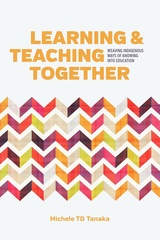
Braided Learning
Illuminating Indigenous Presence through Art and Story
The Truth and Reconciliation Commission and Indigenous activism have made many Canadians uncomfortably aware of how little they know about First Nations, Métis, and Inuit peoples. In Braided Learning, Lenape-Potawatomi scholar and educator Susan Dion shares her approach to learning and teaching about Indigenous histories and perspectives.
Métis leader Louis Riel illuminated the connection between creativity and identity in his declaration, “My people will sleep for a hundred years, but when they awake, it will be the artists who give them their spirits back.” Using the power of stories and artwork, Dion offers respectful ways to address challenging topics including treaties, the Indian Act, the Sixties Scoop, land claims, resurgence, the drive for self-determination, and government policies that undermine language, culture, and traditional knowledge systems.
Braided Learning draws on Indigenous knowledge and world views to explain perspectives that are often missing from the national narrative. This generous work is an invaluable resource for Canadians trying to make sense of a difficult past, decode unjust conditions in the present, and work toward a more equitable future.
This book is a must-read for teachers and education students. It should also be read by students and practitioners in social work, child and youth counselling, policing, and nursing, or anyone seeking a foundational understanding of the histories of Indigenous peoples and of settler colonialism in Canada.
Additional resources, including a video and colour supplement, are available via UBC's cIRcle.
Dion appeals to the reader to be responsible listeners, who, from an Indigenous episteme, do not interrupt the speaker, and instead listen to the whole story, from which they can gain their own insights about themselves. From this, Dion positions settler educators as responsible for learning and teaching the true history of relationships between Indigenous and non-Indigenous peoples for reconciliation to be possible.
Braided Learning is a safe learning space for people at the start of their learning journey about Indigenous education and history. Each reader will take away the parts of the stories that are important to them, just like listeners do when we hear stories in the lodge from our elders. Nobody tells you what to do – you figure it out yourself with some subtle guidance.
This book should be in every educator’s library. It serves as a model for educators to learn and teach about the history of Indigenous Peoples and settler colonialism without fear or reservation. It is exactly what has been asked for over and over again.
Understanding how educators can participate in reconciliation means understanding what stands in the way. Susan Dion understands both. Highly readable, engaging, and passionate, this book moves teachers from apprehension to action. Educators of all levels, read this book and take heed of Dion’s question: ‘So what are you going to do now?’
Susan D. Dion is a Lenape-Potawatomi scholar with Irish-Quebecois ancestry and associate vice-president of Indigenous initiatives at York University. She is widely consulted by community groups, workplaces, and institutions on methods for building more equitable, respectful relationships between Indigenous and non-Indigenous people. She is the author of Braiding Histories: Learning from Aboriginal People’s Experiences and Perspectives.
Introduction: Indigenous Presence
1 Requisites for Reconciliation
2 Seeing Yourself in Relationship with Settler Colonialism
3 The Historical Timeline: Refusing Absence, Knowing Presence, and Being Indigenous
4 Learning from Contemporary Indigenous Artists
5 The Braiding Histories Stories / Co-written with Michael R. Dion
Conclusion: Wuleelham – Make Good Tracks
Glossary and Additional Resources: Making Connections, Extending Learning
Notes; Bibliography












